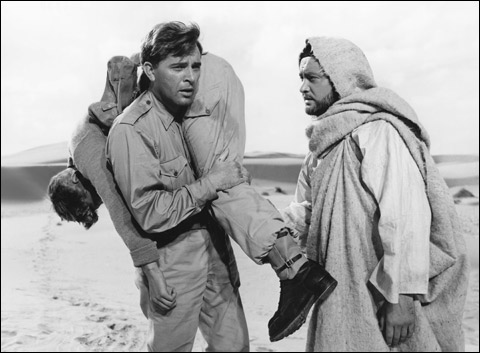
BITTER VICTORY: Each Ray film forms patterns that are hidden in plain sight. |
Whatever truth may still come through the legend of Nicholas Ray — America's cinema poet of outlaws, outsiders, and adolescents, a self-destructive artist ruined by alcohol, drugs, and being too good for
| “NICHOLAS RAY: HOLLYWOOD’S LAST ROMANTIC” | Harvard Film Archive July 9–August 9 |
Hollywood — it's no longer a truth that Ray needs. When much of his work was all but unknown and the "auteur theory" was a minority position held by a band of reputed cranks, special pleading was necessary. But the battle for Ray as a major artist has been won — a victory of which there can be no better sign than the Harvard Film Archive's current retrospective: all his films from his time as a productive commercial filmmaker, from 1947 to 1963, in 35mm prints. The 11 masterpieces among these films (plus a number of weaker but still interesting films) speak for themselves; they need no mythologizing.
Jean-Luc Godard wrote about BITTER VICTORY (1957; July 10 at 9 pm) that it resembled a trick drawing: "One is no longer interested in objects, but in what lies between the objects and becomes an object in its turn." It's an apt comment: each Ray film forms patterns that are hidden in plain sight. The tensions of IN A LONELY PLACE (1950; August 6 at 7 pm; August 9 at 7 pm) get articulated as much through the way paths (of people, of the eye) criss-cross the spaces of a set of Hollywood bungalows as through Humphrey Bogart's manic-depressive starkness as a screenwriter suspected of murder. Expansive in its feeling for the underground West of the rodeo circuit, THE LUSTY MEN (1952; July 24 at 7 pm) is an elegiac piece whose tensions lie in the unstated, unsatisfied longings of three persons (Robert Mitchum, Arthur Kennedy, Susan Hayward). JOHNNY GUITAR (1954; July 23 at 7 pm; July 26 at 7 pm), the first of Ray's color masterpieces, shows his expanding confidence at bending time and space through movement, gesture, and camera angle, finding concise ways to follow changes in complex situations.
Ray's films exist in constant challenge and instability. BIGGER THAN LIFE (1956; July 9 at 7 pm; July 12 at 7 pm) is his greatest film because it is his most unclassifiable. It is, and is not, an attack on American conformism and consumerism. It is, and is not, a psychologically realistic study of a man succumbing to drug addiction. Like other Ray films, it deals with escape, and here every escape route is blocked; a film on the dismalness of ordinary middle-class life in the United States, it is grandiose in its color and designs. Ray's celebrated use of the widescreen CinemaScope process is nowhere defter than in his opening up and shutting down the spaces around his schoolteacher hero (James Mason) and the latter's terrorized family.
CinemaScope is important for Ray, and Ray for CinemaScope, because the stretched screen widens (in the literal sense) the range of choices for depicting the space between people. Editing also plays a crucial part. At the climactic encounter between lawyer Robert Taylor and gangster Lee J. Cobb in PARTY GIRL (1958; July 17 at 7 pm), Ray cuts away to shots of another lawyer, David Opatoshu, looking alarmed but keeping silent. The strangeness of these cutaways is characteristic of Ray, who uses such shots in almost every film: they imply a covert connection or contradiction.